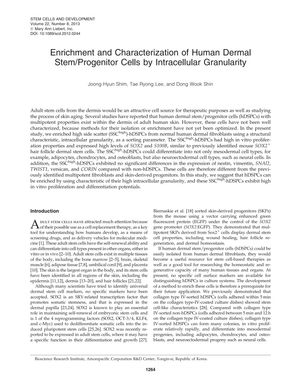TLDR Scientists identified a unique type of human skin stem cell that could help with tissue repair.
In the 2013 study, researchers enriched human dermal stem/progenitor cells (hDSPCs) from normal human dermal fibroblasts using a cell sorting technique based on intracellular granularity. These cells, characterized by high side scatter (SSChigh), showed a three-fold increase in granularity compared to non-hDSPCs and represented less than 3.5% of total fibroblasts. SSChigh-hDSPCs exhibited robust proliferation, expressed high levels of stem cell markers SOX2 and S100B, and were capable of differentiating into both mesodermal and neuroectodermal cell types. The study concluded that SSChigh-hDSPCs are a distinct type of progenitor cell with significant potential for tissue repair and regeneration, and could be efficiently enriched using intracellular granularity. The findings were based on at least three independent experiments, ensuring the reliability of the results, and were supported by a grant from the Korea Healthcare Technology R&D Project.
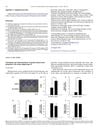 11 citations
,
June 2012 in “Journal of Dermatological Science”
11 citations
,
June 2012 in “Journal of Dermatological Science” Scientists identified a group of human skin cells with high growth and regeneration potential.
1201 citations
,
January 2010 in “Science” Active and quiescent stem cells work together in mammals to maintain and repair tissues.
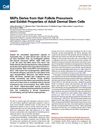 330 citations
,
December 2009 in “Cell stem cell”
330 citations
,
December 2009 in “Cell stem cell” SKPs are similar to adult skin stem cells and could help in skin repair and hair growth.
338 citations
,
July 2009 in “Development” Sox2-positive cells determine specific hair follicle types in mammals.
151 citations
,
February 2006 in “Stem Cells and Development” Hair follicles can be a good source of stem cells like those from bone marrow.
550 citations
,
December 2005 in “The Journal of clinical investigation/The journal of clinical investigation” Researchers successfully isolated and identified key markers of stem cell-enriched human hair follicle bulge cells.
319 citations
,
November 2005 in “Proceedings of the National Academy of Sciences” Hair follicle stem cells can help repair damaged nerves.
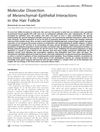 417 citations
,
September 2005 in “PLoS biology”
417 citations
,
September 2005 in “PLoS biology” Understanding gene expression in hair follicles can reveal insights into hair growth and disorders.
268 citations
,
December 2003 in “Experimental Dermatology” Hair follicle cells can become fat and bone cells.
 11 citations
,
June 2012 in “Journal of Dermatological Science”
11 citations
,
June 2012 in “Journal of Dermatological Science” Scientists identified a group of human skin cells with high growth and regeneration potential.
 April 2025 in “Cellular and Molecular Biology”
April 2025 in “Cellular and Molecular Biology” Human dermal stem/progenitor cells can divide and differentiate more than hair follicle dermal papilla cells.
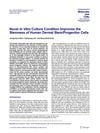 18 citations
,
November 2013 in “Molecules and Cells”
18 citations
,
November 2013 in “Molecules and Cells” New culture method keeps human skin stem cells more stem-like.
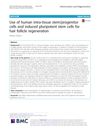 17 citations
,
February 2019 in “PubMed”
17 citations
,
February 2019 in “PubMed” Stem cells can help regenerate hair follicles.
 9 citations
,
August 2015 in “Tissue Engineering and Regenerative Medicine”
9 citations
,
August 2015 in “Tissue Engineering and Regenerative Medicine” Human skin cell byproducts can potentially be used to treat hair loss and promote hair growth.
